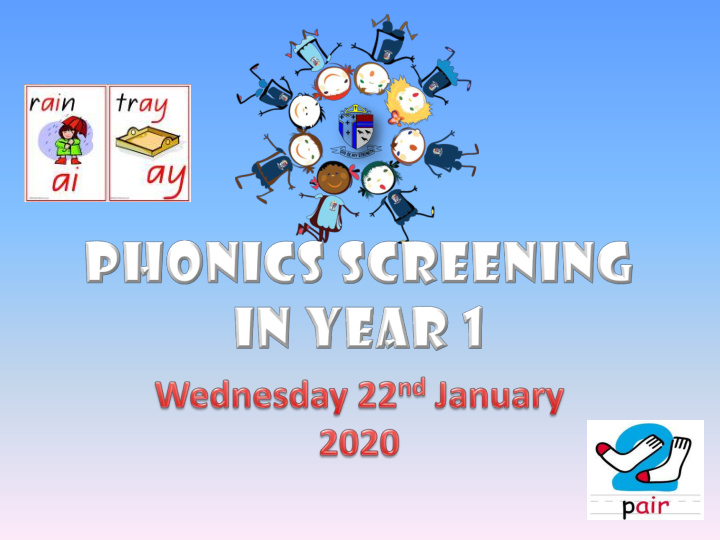



Our Mission Statement … God’s love is at the heart of our Catholic School family. We show this in our respect, kindness and love for others and by treating other people as we wish to be treated ourselves. We will encourage everyone to be the best that we can be.
• Children will be given 40 words to read. 20 of the words are real words and 20 of them are non-words. The non- words or ‘nonsense’ words will have a picture of an alien next to them so children will know they are not real words. • Children will be asked to ‘sound out’ a word and blend the sounds together – e.g. b-e-g = beg or e-c-t = ect • The focus of the check is to see which sounds the children know and therefore the children will be asked to read made up ‘nonsense’ words.
• The screening will take place throughout the week beginning Monday 8 th June. (It is very important your child is in school during this week!) • The children will complete the check one at a time in a quiet area of the school. • Each check will take about 5 - 10 minutes, but some may take longer. • In our experience children seem to enjoy this time spent reading words with the teacher but if a child did become distressed the screen would be stopped at that point.
In previous years the pass mark has been 32 out of 40. Once the school has been informed of the pass mark we will be able to inform you of your child’s results. Whether your child has met the required standard is then shared with parents in the end of year report. If your child has not achieved the expected result, they will receive additional phonics support in Year 2 and will have a chance to re-sit the phonics screen in the final term of Year 2.
• Really is assessing reading • Reading is key • How to approach an unfamiliar word • Braits • Sloam • Spoilt • Strike • phope
Phoneme: The smallest unit of sound. There are approximately 44 phonemes in English (it depends on different accents). Phonemes can be put together to make words. Grapheme: way of writing down a phoneme. Graphemes can be made up from 1 letter e.g. p, 2 letters e.g. sh,(a digraph) 3 letters e.g. igh (a trigraph) Blending- Children blend phonemes together to make a word e.g. r-u-n run Segmenting – Children split the word into sounds to help them write it.
Teaching phonics requires a technical skill in enunciation. Each phoneme needs to be articulated clearly and precisely. Each sound needs to be said sharply and clipped: “D” not “DER” “M” not “MER” for accuracy in blending. https://www.youtube.com/watch?v=MOW3pB2KwGA
Encourage your child to ‘sound out’ when reading or writing. Help them to spot where more than one letter work together to make one sound. Digraph- 2 letters making one sound Cow, Photo Trigraphs- 3 letters making one sound night Split vowel digraphs- 2 vowels with a consonant in-between. spine - i_e make - a_e Soft c: when c makes soft sound : circus, circle:
Support with Jolly Spelling and Grammar homework Use the internet or apps to play phonics games with your child. Some of these games include nonsense words which is good practise for the screening. Here is one of our favourites: Buried Treasure: http://www.phonicsplay.co.uk/BuriedTreasure2.html
Recommend
More recommend